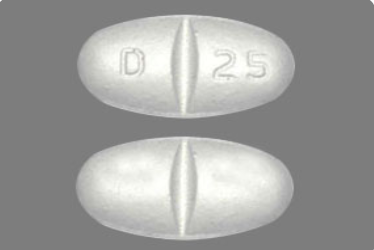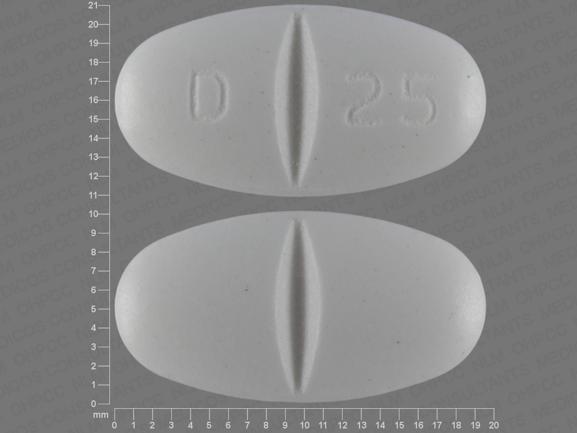Pill with imprint D 25 is White, Oval and has been identified as Gabapentin 800 mg. It is supplied by Aurobindo Pharma USA, Inc.
Gabapentin is used in the treatment of Back Pain; Postherpetic Neuralgia; Epilepsy; Chronic Pain; Seizures and belongs to the drug class gamma-aminobutyric acid analogs. Risk cannot be ruled out during pregnancy. Gabapentin 800 mg is not a controlled substance under the Controlled Substances Act (CSA).


Gabapentin
- Imprint
- D 25
- Strength
- 800 mg
- Color
- White
- Size
- 19.00 mm
- Shape
- Oval
- Availability
- Prescription only
- Drug Class
- Gamma-aminobutyric acid analogs
- Pregnancy Category
- C – Risk cannot be ruled out
- CSA Schedule
- Not a controlled drug
- Labeler / Supplier
- Aurobindo Pharma USA, Inc.
- Inactive Ingredients
- copovidone, corn starch, crospovidone, hydroxypropyl cellulose, magnesium stearate, microcrystalline cellulose, magnesium silicate
Note: Inactive ingredients may vary.
Labelers / Repackagers
| NDC Code | Labeler / Repackager |
|---|---|
| 65862-0524 | Aurobindo Pharma Limited |
| 16714-0332 | NorthStar Rx LLC |
Submitted by: Drugs.com
What is Gabapentin and How to Use it ?
Gabapentin is a medication primarily used to treat seizures (epilepsy) and nerve pain (neuropathic pain). It belongs to a class of medications known as anticonvulsants or antiepileptic drugs. Gabapentin works by affecting certain chemicals and neurotransmitters in the brain involved in seizures and nerve pain.
Here’s how gabapentin is typically used:
- Seizures (Epilepsy): Gabapentin is commonly prescribed as an adjunctive treatment for partial seizures in adults and children aged 3 years and older. It is often used in combination with other antiepileptic medications to help control seizures.
- Nerve Pain (Neuropathic Pain): Gabapentin is also frequently used to treat various types of nerve pain, including diabetic neuropathy, postherpetic neuralgia (nerve pain following shingles), and peripheral neuropathy. It is effective in relieving shooting or burning sensations, tingling, or numbness associated with nerve damage.
Gabapentin is usually taken orally in the form of capsules, tablets, or an oral solution. Here are some general guidelines for using gabapentin:
- Dosage: The dosage of gabapentin varies depending on the individual’s medical condition, age, and response to treatment. It’s essential to follow your doctor’s instructions and the dosage prescribed on the medication label carefully.
- Administration: Gabapentin is typically taken by mouth with or without food. Swallow the capsule or tablet whole with a full glass of water. Do not crush, chew, or break the tablet or capsule unless directed to do so by your doctor.
- Timing: Take gabapentin exactly as prescribed by your doctor. It’s important to take it regularly and at the same times each day to maintain a consistent level of the medication in your body.
- Gradual Dosing: If you are starting gabapentin treatment or increasing the dosage, your doctor may recommend starting with a low dose and gradually increasing it over time to minimize side effects.
- Duration of Treatment: Continue taking gabapentin for the full duration of treatment prescribed by your doctor, even if you start to feel better. Stopping gabapentin suddenly can increase the risk of seizures or other withdrawal symptoms.
- Monitor Side Effects: Pay attention to any side effects you may experience while taking gabapentin and report them to your doctor. Common side effects may include dizziness, drowsiness, fatigue, and weight gain.
- Storage: Store gabapentin at room temperature away from moisture and heat. Keep it out of reach of children and pets.
It’s important to note that gabapentin can interact with other medications, so it’s essential to inform your doctor about all the medications you are taking, including prescription drugs, over-the-counter medications, and supplements. Additionally, never adjust your gabapentin dosage or stop taking it without consulting your doctor first, as sudden changes can lead to serious complications.
